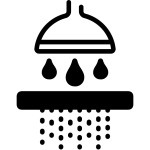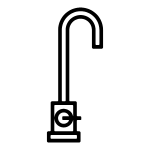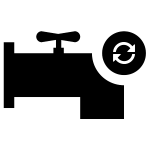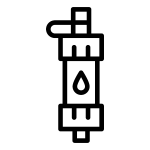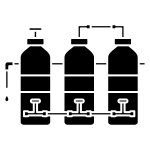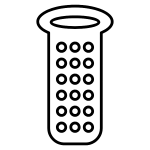Introduction
Access to clean and safe water is essential for healthy living. Whether you’re using a water filter pitcher at home, a whole-house water filtration system, or an under-sink purifier, the effectiveness of your system largely depends on a small but critical component: the water filter cartridge.
In this in-depth guide, we’ll explore everything you need to know about water filter cartridges—what they are, how they work, the types available, how often to replace them, and how to choose the best one for your needs. Whether you’re a homeowner looking for a reliable water purification solution or a business seeking cleaner water for operations, this post will help you make informed decisions.
What Is a Water Filter Cartridge?
A water filter cartridge is a replaceable component of a filtration system that removes impurities and contaminants from water. It sits inside the housing of the water filter unit and performs the actual filtration work. The cartridge traps contaminants such as chlorine, sediment, heavy metals, bacteria, and other unwanted substances, depending on its design.
Over time, the cartridge becomes clogged or saturated with these contaminants, reducing its effectiveness, which is why regular replacement is essential.
Why Water Filter Cartridges Matter
Using the right water filter cartridge is crucial for several reasons:
- ✅ Health Protection: Removes harmful bacteria, viruses, and heavy metals.
- ✅ Improved Taste and Odor: Eliminates chlorine and organic compounds that affect water’s flavor.
- ✅ Appliance Longevity: Reduces scale and sediment build-up in appliances.
- ✅ Cost Efficiency: Prevents plumbing damage and reduces the need for bottled water.
- ✅ Eco-Friendly: Encourages reuse of water filter systems instead of buying new units.
How Water Filter Cartridges Work
Water filter cartridges function based on one or more of the following filtration methods:
1. Mechanical Filtration
Traps particles like dirt, sand, and sediment using a physical barrier—usually a mesh or fiber-based material.
2. Activated Carbon Filtration
Uses porous carbon to adsorb chlorine, volatile organic compounds (VOCs), and bad odors.
3. Ion Exchange
Swaps ions like calcium and magnesium with sodium or hydrogen ions to reduce water hardness.
4. Reverse Osmosis
Uses a semi-permeable membrane to remove up to 99% of contaminants, including fluoride, nitrates, and lead.
5. UV Filtration
Neutralizes bacteria and viruses using ultraviolet light. Often used in combination with other filters.
Common Types of Water Filter Cartridges
There are several types of cartridges available, each tailored to specific water problems:
1. Sediment Filter Cartridges
- Removes: Rust, dirt, sand, and particles.
- Best For: Pre-filtration in homes with dirty or well water.
- Lifespan: 3–6 months.
2. Carbon Block and Granular Activated Carbon (GAC) Cartridges
- Removes: Chlorine, taste, odor, and some pesticides.
- Best For: Municipal water with chlorine treatment.
- Lifespan: 2–6 months.
3. Ceramic Filter Cartridges
- Removes: Bacteria, sediment, and protozoa.
- Best For: Backpackers or areas with biological contaminants.
- Lifespan: Can be cleaned and reused up to a year.
4. Ion Exchange Resin Cartridges
- Removes: Calcium, magnesium (hardness), and heavy metals.
- Best For: Hard water problems.
- Lifespan: 3–6 months.
5. Reverse Osmosis Membranes
- Removes: Fluoride, nitrates, lead, arsenic, and many dissolved solids.
- Best For: Comprehensive filtration needs.
- Lifespan: 2–3 years.
6. Inline Filter Cartridges
- Used In: Refrigerators, ice makers, coffee machines.
- Removes: Chlorine, taste, and odor.
- Lifespan: 6–12 months.
Signs It’s Time to Replace Your Water Filter Cartridge
- Reduced Water Flow – Clogged filters slow down the water pressure.
- Bad Taste or Odor – Unpleasant flavors mean the filter has stopped working.
- Cloudy Water – Poor filtration is letting sediment through.
- Indicator Lights – Some modern filters have change indicators.
- Manufacturer’s Recommended Timeframe – Always follow product instructions.
How to Choose the Right Water Filter Cartridge
When choosing a water filter cartridge, consider these key factors:
✅ Type of Contaminants in Your Water
Test your water for chlorine, bacteria, heavy metals, etc., and match the cartridge accordingly.
✅ Compatibility
Ensure the cartridge fits your filter system (e.g., 10” standard, proprietary filters, etc.).
✅ Filter Capacity
Look for how many gallons a cartridge can treat (e.g., 10,000 gallons, 6 months of use).
✅ NSF/ANSI Certification
Check if the cartridge is certified to remove specific contaminants.
✅ Brand Reputation
Opt for trusted brands like Cuoll, which provide reliable and efficient cartridges.
How to Replace a Water Filter Cartridge (Step-by-Step)
Here’s a general guide, but always follow the manufacturer’s instructions:
- Turn Off the Water Supply
- Relieve Pressure by Opening a Faucet
- Unscrew the Filter Housing
- Remove the Old Cartridge and Dispose
- Clean the Housing
- Insert the New Cartridge
- Lubricate O-Ring and Reassemble
- Turn the Water Back On
- Check for Leaks
- Flush the System (if needed)
Where to Buy High-Quality Water Filter Cartridges
At Cuoll, we offer a wide range of water filter cartridges compatible with various filtration systems. Whether you’re looking for sediment filters, carbon block cartridges, or RO membranes, we’ve got you covered.
Why Buy from Cuoll?
- ✅ Trusted Quality
- ✅ Fast Shipping
- ✅ Affordable Pricing
- ✅ Customer Support
- ✅ 100% Satisfaction Guarantee
Browse our Water Filter Cartridge Collection now and enjoy clean, fresh water every day!
Maintenance Tips to Prolong Cartridge Life
- Clean your housing units every time you change cartridges.
- Install a pre-filter if you have heavy sediment in water.
- Store spare cartridges in a cool, dry place.
- Replace filters on time, even if water still tastes okay.
Frequently Asked Questions (FAQs)
Q1: How often should I change my water filter cartridge?
Answer: It depends on the type, but most cartridges should be replaced every 3 to 6 months.
Q2: Can I reuse a water filter cartridge?
Answer: Most cartridges are not reusable. Some ceramic cartridges can be cleaned and reused.
Q3: Are all cartridges universal?
Answer: No. Some are standard sizes (like 10”), but many are brand-specific.
Q4: What happens if I don’t change my cartridge?
Answer: Water quality will deteriorate, and contaminants may flow through. It can also damage the filter unit.
Q5: Does a new cartridge need flushing?
Answer: Yes. Run water through the new cartridge for a few minutes to remove carbon dust and activate filtration.
Conclusion: Make the Smart Choice for Clean Water
Water filter cartridges may be small, but they play a powerful role in safeguarding your health, appliances, and water quality. Whether you’re dealing with chlorine, sediment, or harmful microbes, the right cartridge makes all the difference.
Don’t wait until your water smells or tastes bad. Stay proactive. Visit Cuoll.com to explore our premium range of water filter cartridges and experience the power of pure, clean water today.


